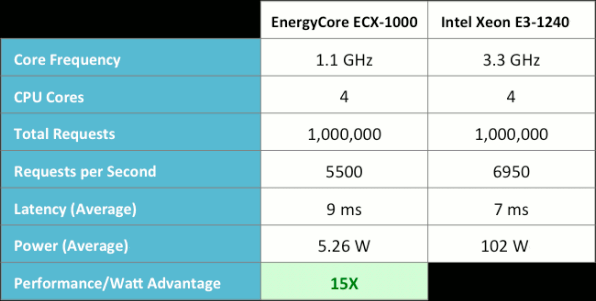Calxeda has released the results of ApacheBench benchmark comparing their ARM-based EnergyCore solution to an Intel Xeon server in order to showcase the performance and the much lower power consumption of their servers.
Here’s the setup:
- Hardware:
- Single Calxeda EnergyCore ECX-1000 @ 1.1 GHz, 4 GB of DDR3L-1066 memory, 1Gb Ethernet network port and 250 GB SATA 7200rpm HDD
- Intel Xeon E3-1240 @ 3.3 GHz, 16 GB memory and 1Gb Ethernet network port. No info on hard drive provided
- Software:
- Ubuntu Server v12.04
- Apache Server v2.4.2
- ApacheBench v2.3 (16k request size)
They performed power measurements every 2 seconds and averaged the results. Power supply overhead and hard drive power consumption were not excluded in the measurement, but the entire SoC and DDR memory power consumption were included together. For the Intel server however, they could not measure directly, so they used published TDP values for the CPU (80 W) and I/O chipset (6.7 W), along with an estimate for DDR memory (16 W). I’m not sure if those assumptions are realistic or not. [Update: Please read the comments for more information on this matter].
Here are the results:

For this particular benchmark, the results are really impressive with Calxeda ARM server being only about 20% slower then an Intel Xeon server while consuming about 5W instead of 102W for the Intel server that is it consumes nearly 20 times less. The Performance/Watt ratio shows a 15 times advantage for the Calxeda ARM server.
Calxeda also explains that the Sandybridge system saturated the single 1Gb NIC with less than 15% CPU utilization, which confirms the number previously mentioned by Mitac.
The company is still working on fine-tuning the power consumption in order to save even more power per watt.
This kind of performance per watt could allow companies managing large datacenters such as Google and Facebook to save several million dollars per year in electricity bills.
One benchmark is usually no enough to have a clear understanding of the performance of a system, so Calxeda also plans to provide some benchmark results running Cassandra database, Hadoop framework, Memcached caching system, and Graph500 benchmark for supercomputers in the future.

Jean-Luc started CNX Software in 2010 as a part-time endeavor, before quitting his job as a software engineering manager, and starting to write daily news, and reviews full time later in 2011.
Support CNX Software! Donate via cryptocurrencies, become a Patron on Patreon, or purchase goods on Amazon or Aliexpress




